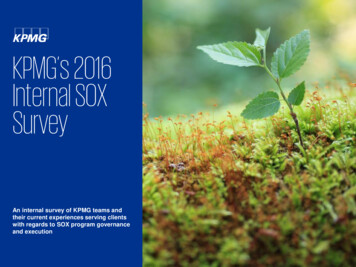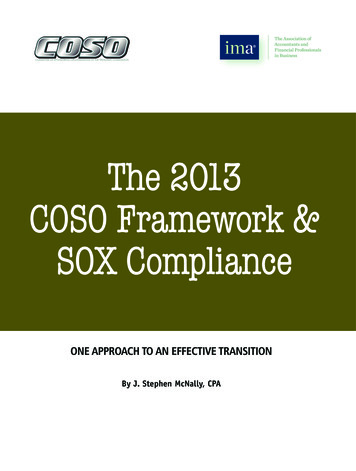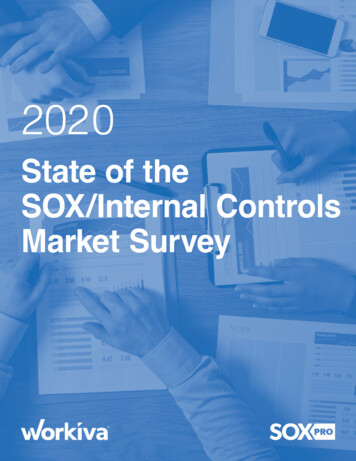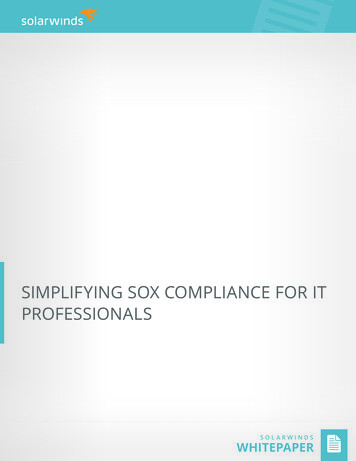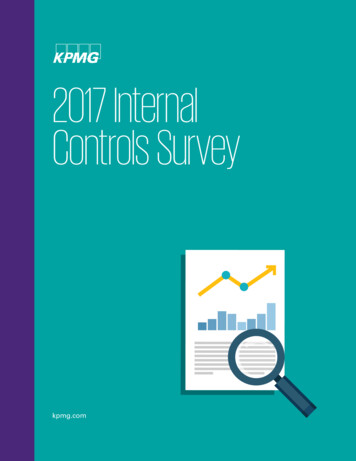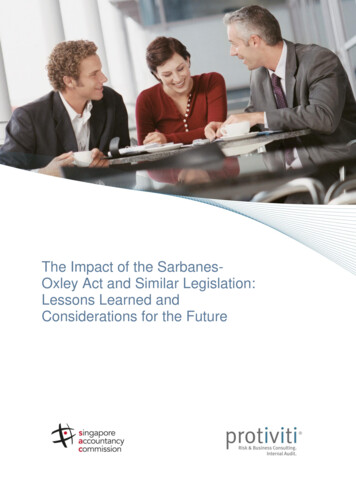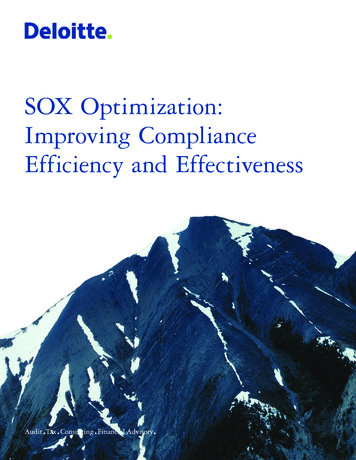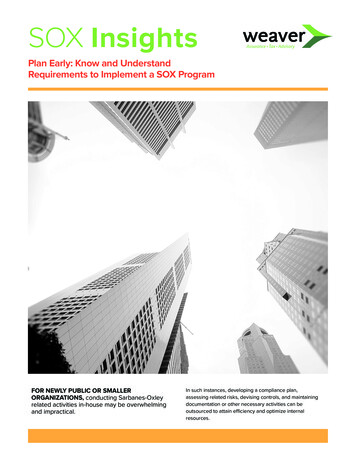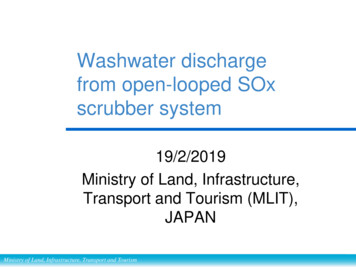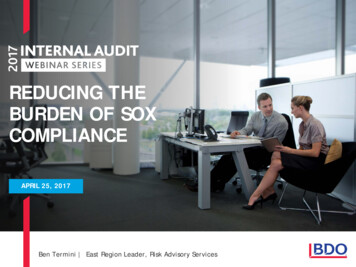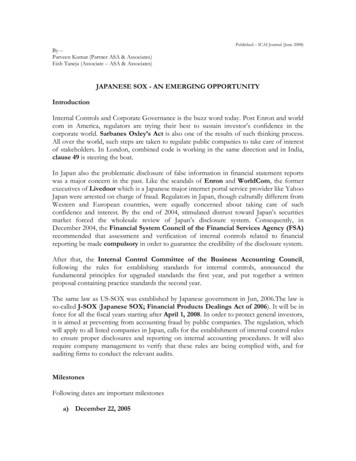
Transcription
By –Parveen Kumar (Partner ASA & Associates)Eish Taneja (Associate – ASA & Associates)Published – ICAI Journal (June 2008)JAPANESE SOX - AN EMERGING OPPORTUNITYIntroductionInternal Controls and Corporate Governance is the buzz word today. Post Enron and worldcom in America, regulators are trying their best to sustain investor‟s confidence in thecorporate world. Sarbanes Oxley’s Act is also one of the results of such thinking process.All over the world, such steps are taken to regulate public companies to take care of interestof stakeholders. In London, combined code is working in the same direction and in India,clause 49 is steering the boat.In Japan also the problematic disclosure of false information in financial statement reportswas a major concern in the past. Like the scandals of Enron and WorldCom, the formerexecutives of Livedoor which is a Japanese major internet portal service provider like YahooJapan were arrested on charge of fraud. Regulators in Japan, though culturally different fromWestern and European countries, were equally concerned about taking care of suchconfidence and interest. By the end of 2004, stimulated distrust toward Japan‟s securitiesmarket forced the wholesale review of Japan‟s disclosure system. Consequently, inDecember 2004, the Financial System Council of the Financial Services Agency (FSA)recommended that assessment and verification of internal controls related to financialreporting be made compulsory in order to guarantee the credibility of the disclosure system.After that, the Internal Control Committee of the Business Accounting Council,following the rules for establishing standards for internal controls, announced thefundamental principles for upgraded standards the first year, and put together a writtenproposal containing practice standards the second year.The same law as US-SOX was established by Japanese government in Jun, 2006.The law isso-called J-SOX (Japanese SOX; Financial Products Dealings Act of 2006). It will be inforce for all the fiscal years starting after April 1, 2008. In order to protect general investors,it is aimed at preventing from accounting fraud by public companies. The regulation, whichwill apply to all listed companies in Japan, calls for the establishment of internal control rulesto ensure proper disclosures and reporting on internal accounting procedures. It will alsorequire company management to verify that these rules are being complied with, and forauditing firms to conduct the relevant audits.MilestonesFollowing dates are important milestonesa) December 22, 2005
Schedule Report of the First Subcommittee of the Financial System Council titled as“Legislation for „the Investment Services Law (provisional title)”b) March 10, 2006Cabinet decision on the following two bills for legislating the “Financial Instrumentsand Exchange Law”i)ii)bill for amending the Securities and Exchange Law and otherfinancial lawsbill for abolishing and amending the related laws to implement theabove bill for amending the Securities and Exchange Law and otherfinancial lawsc) March 13, 2006Submission of the bills to the Diet (Japanese Legislature)d) June 7, 2006Passage of the bills in the Diete) June 14, 2006Promulgation of the legislationsf) April, 2008J-SOX Mandatory requirement for Listed CompaniesCompliance RequirementsThe U.S. Public Company Accounting Reform and Investor Protection Act of 2002 („SOXAct‟) consist of 11 titles containing a total of 69 sections. The stipulations in Section 404 ofTitle IV-US SOX are similar in content to the provisions and stipulations contained in bothArticle 24, Section 4, Paragraph 4 of Japan’s Financial Instruments and ExchangeLaw and Article 193, Section 2, Paragraph 2 of Japan’s Securities and Exchange Law.These legal provisions are sometimes referred to as the Japanese version of the SOX Act.Besides other important issues, as per section 24-4-4 of the Financial Service Act, 2006 ofJapan, all the listed corporate will have to present a report on Internal Controls as part ofAnnual Financial Reports for the fiscal years starting after April 1, 2008.The difference in adoption of US-SOX & J-SOX
SOX act is the same and both US Sox and J Sox have focus on documentation and puttingresponsibility on the management, yet there are some key differences in the Countries andthe way it has to be adopted in both places.a) The biggest difference between the two countries lies in the methodology employedby outside auditors. In the United States, the main method used is direct reporting,whereby accountants go to company‟s offices to audit where the risks lie and verifywhether the checking function is working or not. In Japan, on the other hand,auditors mainly conduct indirect inspections.b) Japan will not adopt the type of direct reporting approach used in the United States,because it can be assumed that this is already being implemented during inspectionsconducted by in-house auditors which are installed in corporate structure in Japan.c) The major burden for SOX compliance is documentation of all of the activities in acompany. It makes additional cost of more than 3-5 million dollars. If J-SOX followsUS-SOX as it is, it must arouses devaluation of all Japanese public companies andelevate the hurdle of IPO. Therefore, not only executives of Japanese publiccompanies but also some of the Committee members insist that it should be muchsimpler than US-SOX.d) Liquidation of employees in Japanese economy is less than that of the US. Businessprocess and business rules are handed down from person to person. They are notclearly documented in detail. There are very few manuals / SOP‟s in Japan unlike inUS where the Focus on Documentation is much higher.FrameworkImplementing Standards on the assessment and audit of internal controls over FinancialReporting” is composed of three parts;1) Internal Control Framework2) Assessment of Internal Control over Financial Reporting and3) Auditing Internal Control over Financial Reporting.Though it would follow the Internal Control Framework of COSO, 1 additional item isincluded for each objective and composing elements. In short, the 4th objective, ”Custodyof Assets” and the 6th composing elements “IT (Information Technology)” was added.
Japanese COSO FrameworkEfficiency &Effectiveness ofBusinessReliability ofFinancialReportingControlRiskCustodyof AssetsEnvironmentAssessm entControlInform ationComplianceWith related lawsand regulationsandandHandlingActivityCom m unicationMonitoringIT (Information Technology)Some specific Parameter’s to be observed while working for J-SOXFor a Chartered Accountant, it is important to know some protocols to enter Japanesemarket1. It takes long time to built confidence among Japanese clients. Communication andpre planning is critical. A Japanese company would like to know beforehand thetimelines. Once committed, it is very difficult to convince them about the delay.2. Sharing case studies is very effective. So the best way is the get your acceptance inone and then that Business case gets you more Business.3. You have to start with Zero base. The most popular solution in the US / India is notnecessarily corresponded to the most popular one in Japanese market. It means thatyou have a chance to make big success even if you are not listed on top Ranks‟ inUS/Indian market.4. You should cooperate with influential system consultants, integrators and strongdistributors. When you speak with Japanese candidates as partner, do not hurry tomake a contract. They start business without it.Planning AheadCompanies listed in Japan and operating in India as subsidiary companies, will need toReport the J-SOX Compliance to the main Companies in Japan.To implement the guidelines and preparing documentation, attention is to be given on
(i)Defining Process(ii)Documentation of Process Maps(ii)Defining the risks and controls in the process(iii)After identifying the risk at each step, implementation of controls documentthe steps taken to mitigate the such risks and implementation of Controls tocounter the Risk(iv)Testing of the Process regularly(v)Reporting to Management the results of the tests and the controls in place.A Chartered Accountant is the best person to help in the compliance of J-SOX. To preparefor J-SOX compliance, documentation is must. A workflow tool is very helpful to drawbusiness flow and document business activities. Tools like MS-Visio or MS-Excel/MS-wordhelp in a big way in documentation. Following is an example of defining process, mappingand identifying risks and controls.
StartA Purchase Process adopted in aJapanese MNC operating in IndiaR1ProductionDeptt. receivesProduction Planfrom itsCustomersC1Sales Target ismade by ManagerSales & approvedby MDYR2Based On salestarget, ProductionTarget is madeC2Production Deptmakes, Packs &hand over Finalproduct to salesOther departmentsmake theirPurchase planbased on theirtargetsThe departmentsraise a purchaserequisitionproviding theirrequirementIf the item is belowRs. 5,000/-, no POis issued andpayment is uponacceptanceorAbove 5,000 andmaintenance itembased onrequirement ofmain. deptt.PurchaseDepartment IssuesPurchase Order tothe ChosenVendorCash payment ismade to theVendor afterapproval of itemRisk Associated:1. Incorrect Production Plan from Customer2. Wrong plan made by Sales ManagerControl:1. Review every month Production Plan vs.Actual Purchases2. Approved by MD, management KnowledgeorCash payment ismade to theVendor afterapproval of itemEndAbove 5000 andraw materialdomestic – to beused in prodn.orAbove Rs.5000and raw materialImported- to beused in prodn.Material isreceived fromVendors based onPO issued (GRN)made at GateMaterial I s send toQC department forquality checkPurchaseDepartment getsthe okay materialfrom QC- It thenissues these toProdn. DepartmentQC Checks theitem & accordinglyapproves/rejectsthe item
The same law as US-SOX was established by Japanese government in Jun, 2006.The law is so-called J-SOX (Japanese SOX; Financial Products Dealings Act of 2006). It will be in force for all the fiscal years starting after April 1, 2008. In order to protect general investors, it is aimed at preventing from accounting fraud by public companies.
